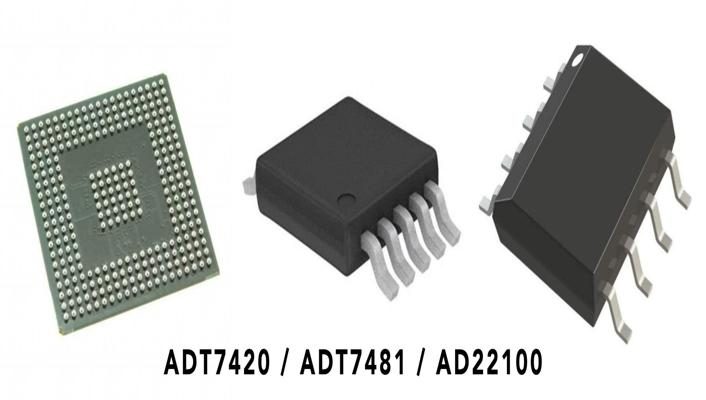
Introduction
Temperature sensors are among the most widely used sensing components in electronic systems. Whether in industrial automation, medical devices, server thermal management, or consumer electronics and HVAC systems, temperature measurement is directly tied to the safety, stability, and efficiency of equipment.
Different applications demand very different sensor characteristics: some require ultra-high accuracy of ±0.25 °C, others emphasize multi-point monitoring with over-temperature alarms, while others prioritize low cost and simple interfaces.
This article compares three representative devices:
ADT7420UCPZ — High-accuracy digital temperature sensor
ADT7481ARMZ-1 — Dual-channel digital temperature sensor
AD22100AR — Analog linear temperature sensor
By comparing their operating principles, key parameters, and application scenarios, we aim to help engineers quickly identify the right solution.
Product Positioning and Parameter Comparison
| ADT7420UCPZ | ADT7481ARMZ-1 | AD22100AR | |
| Type | High-precision digital sensor | Digital temperature sensor (dual-channel) | Analog temperature sensor |
| Temperature Range | -40 ℃ to +150 ℃ | Local: 0 ℃ to 127 ℃Remote: -64 ℃ to +191 ℃ | -50 ℃ to +150 ℃ |
| Accuracy | ±0.25 ℃(–40 to +105 ℃) ±0.5 ℃(full range) | ±1 ℃(typ.) | ±2 ℃(typ.) |
| Interface/Output | I²C / SMBus | SMBus | Analog voltage output |
| Features | High resolution (0.0078 °C), low power, compact package | Supports external diodes, over-temp alarm, programmable resolution | Simple to use, minimal external components, low cost |
| Typical Applications | Medical equipment, industrial automation, environmental monitoring | Servers, telecom equipment, industrial thermal management | HVAC systems, appliances, general-purpose industrial instruments |
Operating Principles and Typical Circuits
ADT7420UCPZ — Integrated Digital Temperature Sensor
Principle: Utilizes a bandgap reference circuit to convert temperature changes into voltage, followed by 16-bit ADC conversion to digital data.
Interface: Provides temperature readings directly in °C via I²C/SMBus.
Typical Circuit: VCC at 3.3 V or 5 V; SDA/SCL connected to MCU I²C bus with 2.2–4.7 kΩ pull-up resistors.
ADT7481ARMZ-1 — Dual-channel Temperature Sensor
Principle: Local channel measures on-chip temperature; remote channel monitors junction temperature via an external diode’s Vbe temperature characteristic.
Interface: Communicates over SMBus, with configurable resolution and over-temp alarm thresholds.
Typical Circuit: Remote diode requires differential routing, kept away from strong noise sources; RC filtering recommended when necessary.
AD22100AR — Analog Linear Temperature Sensor
Principle: Exploits the linear relationship between semiconductor voltage and temperature, outputting a proportional analog voltage.
Interface: Provides voltage output with a typical slope of 22.5 mV/°C.
Typical Circuit: VOUT connected to MCU ADC or comparator; RC filtering on VOUT improves noise immunity.
Accuracy and Design Considerations
Power Supply Stability: Digital sensors are less sensitive to power ripple, while analog sensors are highly susceptible. A dedicated reference or low-noise LDO is recommended.
Self-heating: Excessive sampling frequency can cause self-heating. Use lower sampling rates or enable low-power mode.
Remote Diode Selection: For ADT7481, accuracy depends on diode characteristics. Use vendor-recommended diodes or CPU built-in thermal diodes.
PCB Layout: Remote sensing traces must be short and matched; analog sensor outputs should avoid high-frequency or high-current traces.
Recommended Application Scenarios
Medical / Precision Instruments → ADT7420UCPZ
Advantage: ±0.25 °C accuracy, 0.0078 °C resolution.
Examples: Ventilators, incubators, laboratory measurement systems.
Design Tip: Use two-point calibration with MCU filtering algorithms to minimize temperature fluctuations.
Servers / Telecom / Industrial Control → ADT7481ARMZ-1
Advantage: Local + remote dual channels for hotspot monitoring; supports over-temp alerts.
Examples: Server motherboard thermal management, 5G base stations, industrial drive cabinets.
Design Tip: Set appropriate thresholds and hysteresis to avoid frequent fan toggling.
HVAC / Appliances / General Industrial → AD22100AR
Advantage: Analog voltage output, simple interface, low cost.
Examples: Air conditioning control, refrigerator anti-freeze protection, appliance thermal safety.
Design Tip: Apply RC filtering for stable output; ensure tight thermal coupling to the heat source.
The key to temperature sensor selection lies in balancing accuracy, channel count, and cost:
ADT7420UCPZ → Best for accuracy-driven applications such as medical and high-end industrial.
ADT7481ARMZ-1 → Ideal for multi-point monitoring and thermal management in servers and telecom equipment.
AD22100AR → Best suited for cost-sensitive HVAC and appliance markets.
Extended Notes
Supply Risks:
ADT7420UCPZ → Limited market availability.
ADT7481ARMZ-1 → Currently in the process of being discontinued (EOL).
AD22100AR → Widely available; substitutes exist from multiple vendors.
When selecting devices, engineers must consider both lifecycle risks and availability of alternatives. WIN SOURCE can provide inventory support and replacement options to mitigate supply chain uncertainty.
© 2025 Win Source Electronics. All rights reserved. This content is protected by copyright and may not be reproduced, distributed, transmitted, cached or otherwise used, except with the prior written permission of Win Source Electronics.

COMMENTS